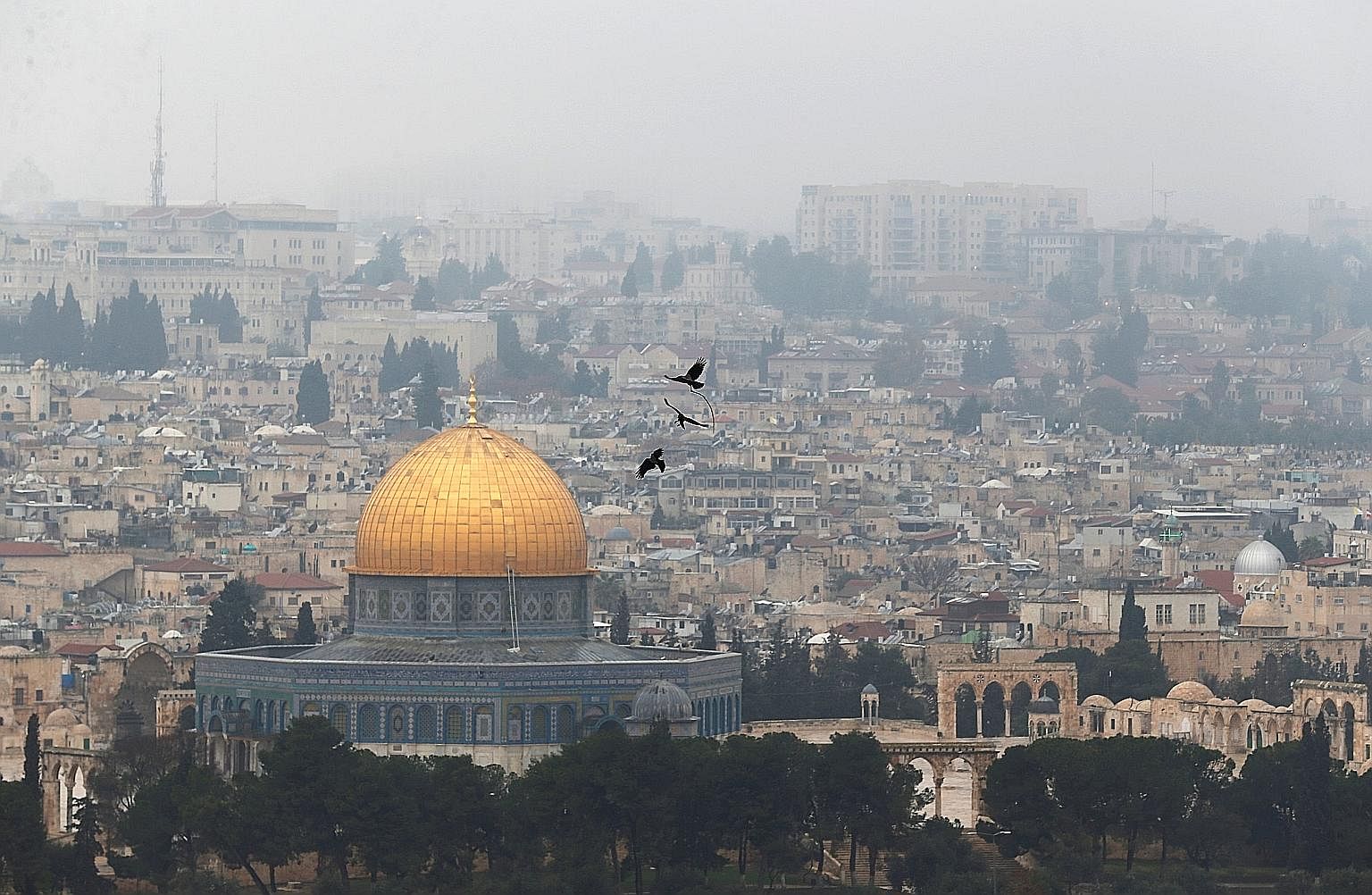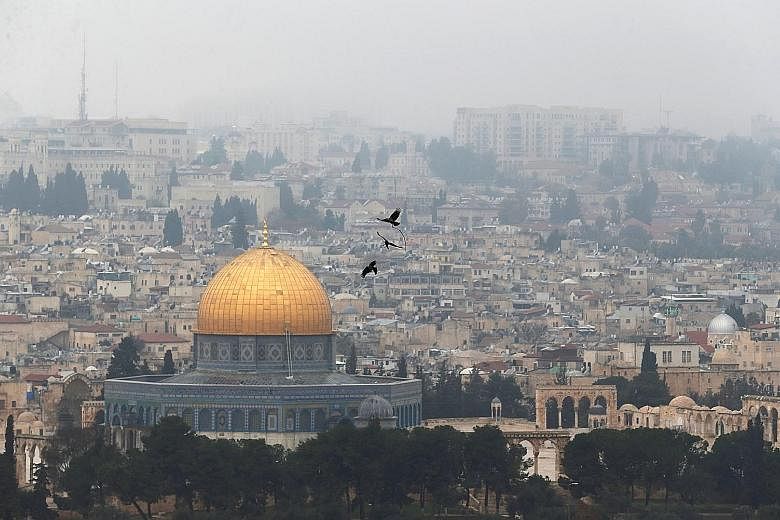For over 20 years now, the peace process between Israelis and Palestinians has been a tango: a step forward, then two backwards, to remain in a total freeze for the last two years. Negotiators came close to an agreement. Both sides compromised on water and security, electromagnetic frequencies, borders and even the right of return of Palestinian refugees. Until Jerusalem came on the table - the one issue without an acceptable, viable solution.
President Donald Trump's decision last month to recognise the city as the capital of the Jewish state and move the US Embassy from Tel Aviv to Jerusalem has been met with uproar across the Arab and Muslim world, much of which appears to have abated.
The debate focuses on one little mountain on the eastern rim of Jerusalem's Old City. Jews call it the Temple Mount, because it once housed the temples that were the national and religious centre of their people. In its midst is a rock Jews call the foundation stone which, according to their belief, was the first thing made by the act of creation, an eternal interface between Earth and the Heavens.
Incidentally, Muslims know this boulder all too well. It lies right under the Dome of the Rock, the oldest Islamic sacral structure in the world. They venerate it as the place from which Prophet Muhammad ascended to heaven in his enigmatic night journey mentioned in the Quran.
Next to it, on the plot Muslims call "Al haram al sharif" - the Noble Sanctuary - stands Al-Aqsa, considered the third holiest mosque in the world.
For Jews, the Temple Mount is the very core of their existence. But Palestinians also claim their state would make no sense if its flag does not fly over the Haram. "Were it not for Al-Aqsa", one Palestinian negotiator said, "Arabs would not give a darn about us".
This small rock has become the greatest stumbling block for peace. How did it become so holy for Islam?

According to Jewish belief, King David conquered the city around 1000BC and made it the capital of his kingdom, which for the first time united the 12 eternally squabbling Jewish tribes under one rule. David's son Solomon elevated the city from political to spiritual centre when he erected a temple here that would serve as the central place of worship.
It would take centuries, however, before Jerusalem became the only spiritual centre of the Jewish world. The Jewish kingdom split after Solomon's death. The northern realm of Israel was the richer and more developed one, with its own temples. Impoverished and marginalised Judah, which retained Jerusalem as its capital, luckily remained on the sidelines of world history, for when the Assyrians destroyed Israel in 722BC, they simply could not be bothered to expend their energies on this little mountain village.
For Jerusalem, it was a turning point. With its population bolstered by refugees from the northern kingdom, Jerusalem remained the only spiritual centre of Jews. Here, the combined elites of both kingdoms wrote and codified the Bible. During the reign of King Josiah (649-609BC), who commenced the transformation of Judaism into the unique mixture of monotheistic religion, nationhood and ancestry that it is today, Jerusalem became the Jews' only centre, with the Temple Mount designated as God's dwelling place on earth.
Jerusalem is also central for many Christians, being the city where Jesus Christ preached, was crucified, and buried. Crusades were fought during the Middle Ages to recover the Holy Land, and the city remains a pilgrimage site for Christians to this day.
The city is also connected to the beginning of Islam. The early Muslims first prayed towards Jerusalem, before facing Mecca in prayer. That is why even today, al qiblah al ula - the first direction of prayer - is a synonym for Jerusalem.
After Prophet Muhammad died, his successors started the most successful conquest in human history. Jerusalem was special. In 638, the second Caliph Omar entered the city clad in white robes on a white camel. Back then, Muslims too believed that the Temple Mount had once housed a Jewish sanctum. By 691, the Dome of the Rock adorned the holy hill.
EXALTED STATUS
But Jerusalem was not as holy yet as it is today. The Quran does not contain the word Jerusalem, but speaks of the "Masjid Al-Aqsa" - the furthest place of prostration. The oral tradition (Hadith) narrates that one night, the Archangel Gabriel appeared to the Prophet and ordered him to follow. Riding on the fabled al Buraq, a white, winged donkey with a beautiful countenance, Prophet Muhammad trailed Gabriel to where Al-Aqsa stands, whence he ascended to heaven. There God instructed him how often Muslims should pray.
Jerusalem's exalted status developed much later. After the third caliph was assassinated, the Prophet's cousin and son-in-law Ali took charge. A group under the leadership of Muawiyah demanded he punish his predecessor's murderers. He refused, and Muawiyah refused to acknowledge his rule.
The discontent started a rebellion that split Muslims to this day. When Ali was killed in a mosque in Kufa in the year 661, Muawiyah, governor of Syria and Egypt, gathered his notables on the Haram and declared himself caliph. The followers of Ali view this as treason: Only his descendants are entitled to lead the believers, they contend. To the present day, they call themselves the party of Ali, or Shi'at Ali - Shi'ites in short.
Muawiyah, who began his career on the Temple Mount in Jerusalem, turned the city into one of the centres of his empire. Jerusalem's Arabic name Al Quds - the Holy - became commonplace only in the 10th century.
In early Islam, some scholars rejected the veneration of Jerusalem as a "Judaisation" of Islam. Its central status could very well have been a late result of the Crusades.
Initially, there was no outrage in the Muslim world when the Christians conquered the city in 1099. They viewed it as another phase in the ongoing battle between orient and occident. Caliph al-Mustazhir Billa reacted with indifference when the Qadi of Damascus, Abu Saad al Harawi, reported the loss of Jerusalem. Outraged, Harawi tried to rally the believers with a trick: He sat down in Baghdad's great mosque in the middle of Ramadan and ate. A furious crowd soon gathered around him menacingly, but Harawi retorted in righteous anger how they could be so outraged he was breaking the fast, yet remain so indifferent to the death of thousands of Muslims and the destruction of Jerusalem. Even this stunt failed to galvanise the masses.
Jerusalem would become a battle cry only 50 years later, when the crusader kingdom, also called Outremer, became a nuisance to the rulers of Aleppo. The crusaders' kingdom divided their realm, which stretched to Egypt.
Out of political necessity, the conquest of Jerusalem became a religious obligation. The rulers sponsored the publication of countless Fada'il al Quds, poems extolling Jerusalem's merits as the navel of the world. They portrayed the city as an Islamic sanctuary, whose holiness resulted from the night journey. The religious fervour this created would serve Saladin to motivate his soldiers to capture Jerusalem 100 years later.
MIXING RELIGION AND POLITICS
This success established a pattern. Again and again, Jerusalem would play a central role when it was out of reach and its symbolic value served one's political ends.
Like in the beginning of the 20th century, when the British Mandate and the Zionist enterprise gave rise to Palestinian nationalism. The first riots in Palestine broke out in 1920, after Hajj Amin al Husseini, later Great Mufti of Jerusalem, whipped up a religious frenzy by disseminating the rumour that the Jews planned to raze the Al-Aqsa mosque.
Husseini was a leader who knew how to mix politics and religion. This blend was the secret of his success. It underlies the achievements of many political movements in the Middle East today. For centuries, this region was ruled by the multi-ethnic Ottoman Empire, followed by dysfunctional, autocratic regimes created by European colonial powers.
So far, they have failed to bring their inhabitants stability, security or prosperity. Little surprise that nationalism has no traction and cannot nurture collective identity. Instead, collective identity organises around religion, which serves as a rallying cry for groups with worldly interests.
Only when one understands this role of religion can one comprehend the paramount importance the Al haram al Sharif and Al-Aqsa mosque play in Palestinian consciousness. They are a religious and a political sanctuary at the same time. Losing them is paramount to forfeiting the central organising principle of Palestinian identity.
Using Jerusalem as his battle cry, Husseini, much like Saladin, could rally masses far beyond Palestine's border. Ever since, for entire generations of young Arabs, the city and its loss to Israel have become a symbol of Muslim subjugation by the West.
America's recognition of Jerusalem as the capital of the Jewish state makes this Arab powerlessness painfully clear. When 56 Muslim states conferred in Turkey to condemn Washington in their sharpest language, it was also due to their shared sense of ongoing humiliation and historical injustice.
Nonetheless, only several thousand Palestinians have attended the "mass rallies" their leadership has called for. Merely half of the 56 states that took part in the emergency session of the Organisation for Islamic Cooperation in Turkey dispatched their head of state. Its result was heavy on words and light on action.
This reaction is as far from general upheaval as Jerusalem's myths are from historic fact. It seems seven years of Arab internecine strife and a cornucopia of other problems have taken their toll and diminished Jerusalem's lure.
At the very least, the Arab Spring seems to have left many people in the Arab world exhausted. Not least Jerusalem's Palestinians, who make up 34 per cent of the city's 850,000 inhabitants. Even they, who would be most affected by any political change, have staged very few protests, resigning themselves to token demonstrations at certain hot spots around the Old City after Friday prayers.
The rest of Jerusalem, even though a little quieter and more intensely guarded by heavily armed Israeli security forces than usual, remains a praying, working and even partying metropolis. Little of the frenzy this city once evoked remains alive today. For now, Arab states put their own narrow interests over a common goal of reconquering Al Quds - as they have so often before.
• Dr Gil Yaron is the author of several critically acclaimed books about the Middle East and Jerusalem, including Jerusalem - A Historical Political Travel Guide, that has appeared in German and Czech.


